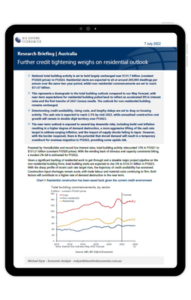Further credit tightening weighs on residential outlook

Powered by HomeBuilder and record low interest rates, total building activity rebounded 13% in FY2021 to $131.21 billion (constant FY2020 prices). With the winding back of stimulus and capacity constraints biting, a modest 2% fall is estimated for FY2022.
Given a significant backlog of residential work to get through and a sizeable major project pipeline on the non-residential building front, total building starts are expected to rise 3% to $133.31 billion in FY2023. With the sharp profile of recent cash rate target rises, the trajectory of credit availability has worsened. Construction input shortages remain acute, with trade labour and material costs continuing to firm. Both factors will contribute to a higher rate of demand destruction in the near term.
What you will learn:
-
National total building activity is set to hold largely unchanged near $131.7 billion (constant FY2020 prices) to FY2024. Residential starts are expected to sit at around 200,000 dwellings per annum over the same two-year period, whilst non-residential commencements are set to reach $51.67 billion.
-
This represents a downgrade to the total building outlook compared to our May forecast, with near-term expectations for residential building pulled back to reflect an accelerated lift in interest rates and the first tranche of 2021 Census results. The outlook for non-residential building remains unchanged.
-
Deteriorating credit availability, rising costs, and lengthy delays are set to drag on housing activity. The cash rate is expected to reach 2.5% by mid-2023, while annualised construction cost growth will remain in double-digit territory over FY2023.
Tags:
Related posts

Post
The socio-economic impact of TikTok in Australia
This report provides the results of our economic modelling of TikTok’s economic contribution to the Australian economy, as well as the findings of survey research into TikTok’s users and Australian businesses. It looks at the real world impacts users report as well as the diversity of TikTok’s online communities.
Find Out More
Post
Australian office sustainability outcomes underpin asset performance
The focus on green office buildings and sustainability is being driven by both government targets to achieve net zero and increasing corporate and investor focus on environmental, social, and corporate governance (ESG) considerations and compliance.
Find Out More
Post
Indian and Australian cities to outpace rivals over 2024-28
We forecast Indian cities to outpace the rest of APAC in terms of GDP growth over the medium term (2024-28). Southeast Asian cities such as Ho Chi Minh City and Jakarta will come close to matching Indian cities and will outperform Chinese ones. Among advanced APAC cities, we expect that Australian ones will fill the top two positions in terms of medium-run GDP growth.
Find Out More